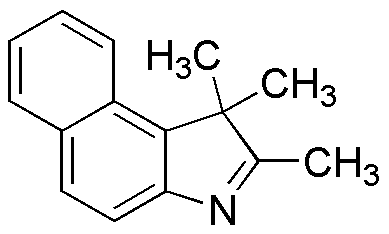2,3,3-Trimethyl-4,5-benzo-3H-indole is widely utilized in research focused on:
- Pharmaceutical Development: This compound serves as a key intermediate in the synthesis of various pharmaceuticals, particularly in developing drugs that target specific biological pathways.
- Organic Synthesis: It is employed in organic chemistry for the construction of complex molecules, enabling researchers to create new compounds with desired properties.
- Material Science: The chemical is used in the development of advanced materials, including polymers and coatings, that exhibit enhanced durability and performance.
- Biological Research: It has applications in studying biological systems, particularly in understanding the mechanisms of action of certain enzymes and receptors.
- Fluorescent Probes: This compound can be utilized in the design of fluorescent probes for imaging applications, providing researchers with tools for visualizing cellular processes.
General Information
Properties
Safety and Regulations
Applications
2,3,3-Trimethyl-4,5-benzo-3H-indole is widely utilized in research focused on:
- Pharmaceutical Development: This compound serves as a key intermediate in the synthesis of various pharmaceuticals, particularly in developing drugs that target specific biological pathways.
- Organic Synthesis: It is employed in organic chemistry for the construction of complex molecules, enabling researchers to create new compounds with desired properties.
- Material Science: The chemical is used in the development of advanced materials, including polymers and coatings, that exhibit enhanced durability and performance.
- Biological Research: It has applications in studying biological systems, particularly in understanding the mechanisms of action of certain enzymes and receptors.
- Fluorescent Probes: This compound can be utilized in the design of fluorescent probes for imaging applications, providing researchers with tools for visualizing cellular processes.
Documents
Safety Data Sheets (SDS)
The SDS provides comprehensive safety information on handling, storage, and disposal of the product.
Product Specification (PS)
The PS provides a comprehensive breakdown of the product’s properties, including chemical composition, physical state, purity, and storage requirements. It also details acceptable quality ranges and the product's intended applications.
Certificates of Analysis (COA)
Search for Certificates of Analysis (COA) by entering the products Lot Number. Lot and Batch Numbers can be found on a product’s label following the words ‘Lot’ or ‘Batch’.
Numéro de catalogue
Numéro de lot/série
Certificates Of Origin (COO)
This COO confirms the country where the product was manufactured, and also details the materials and components used in it and whether it is derived from natural, synthetic, or other specific sources. This certificate may be required for customs, trade, and regulatory compliance.
Numéro de catalogue
Numéro de lot/série
Safety Data Sheets (SDS)
The SDS provides comprehensive safety information on handling, storage, and disposal of the product.
DownloadProduct Specification (PS)
The PS provides a comprehensive breakdown of the product’s properties, including chemical composition, physical state, purity, and storage requirements. It also details acceptable quality ranges and the product's intended applications.
DownloadCertificates of Analysis (COA)
Search for Certificates of Analysis (COA) by entering the products Lot Number. Lot and Batch Numbers can be found on a product’s label following the words ‘Lot’ or ‘Batch’.
Numéro de catalogue
Numéro de lot/série
Certificates Of Origin (COO)
This COO confirms the country where the product was manufactured, and also details the materials and components used in it and whether it is derived from natural, synthetic, or other specific sources. This certificate may be required for customs, trade, and regulatory compliance.


